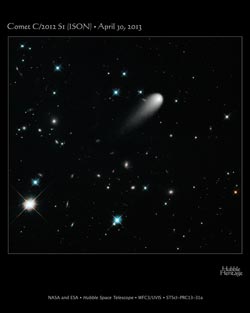NASA’s Hubble: Galaxies, Comets, and Stars! Oh My!

<br>
In reality, the comet is much, much closer. The nearest star to the sun is over 60,000 times farther away, and the nearest large galaxy to the Milky Way is over thirty billion times more distant.
These vast dimensions are lost in this deep space Hubble exposure that visually combines our view of the universe from the very nearby to the extraordinarily far away.
In this composite image, background stars and galaxies were separately photographed in red and yellow-green light. Because the comet moved between exposures relative to the background objects, its appearance was blurred. The blurred comet photo was replaced with a single, black-and-white exposure. The images were taken with the Wide Field Camera 3 on April 30, 2013.
The Hubble Space Telescope is a project of international cooperation between NASA and the European Space Agency. NASA's Goddard Space Flight Center in Greenbelt, Md., manages the telescope. The Space Telescope Science Institute
(STScI) in Baltimore, Md., conducts Hubble science operations. STScI is operated by the Association of Universities for Research in Astronomy Inc., in Washington, D.C.
For image files and more information about Comet ISON, visit:
http://hubblesite.org/news/2013/31
http://heritage.stsci.edu/2013/31
For more information about the Hubble Space Telescope, visit:
http://www.nasa.gov/hubble
Image Credit: NASA, ESA, and the Hubble Heritage Team (STScI/AURA)
Text Credit: Ray Villard, Space Telescope Science Institute, Baltimore, Md.
Media Contact
All latest news from the category: Physics and Astronomy
This area deals with the fundamental laws and building blocks of nature and how they interact, the properties and the behavior of matter, and research into space and time and their structures.
innovations-report provides in-depth reports and articles on subjects such as astrophysics, laser technologies, nuclear, quantum, particle and solid-state physics, nanotechnologies, planetary research and findings (Mars, Venus) and developments related to the Hubble Telescope.
Newest articles

High-energy-density aqueous battery based on halogen multi-electron transfer
Traditional non-aqueous lithium-ion batteries have a high energy density, but their safety is compromised due to the flammable organic electrolytes they utilize. Aqueous batteries use water as the solvent for…

First-ever combined heart pump and pig kidney transplant
…gives new hope to patient with terminal illness. Surgeons at NYU Langone Health performed the first-ever combined mechanical heart pump and gene-edited pig kidney transplant surgery in a 54-year-old woman…

Biophysics: Testing how well biomarkers work
LMU researchers have developed a method to determine how reliably target proteins can be labeled using super-resolution fluorescence microscopy. Modern microscopy techniques make it possible to examine the inner workings…





















